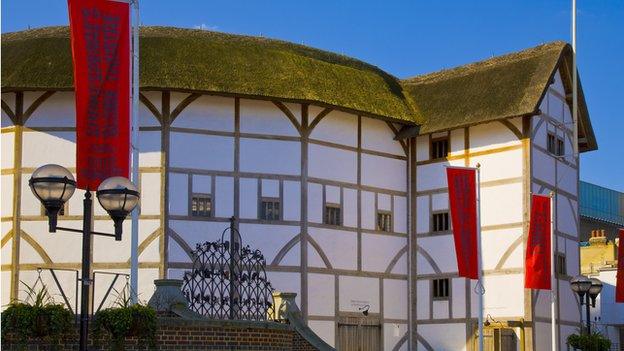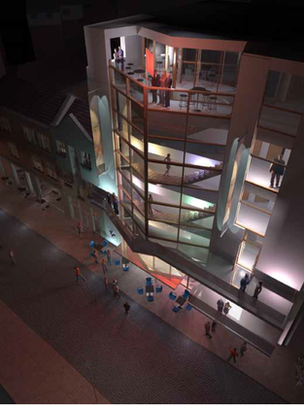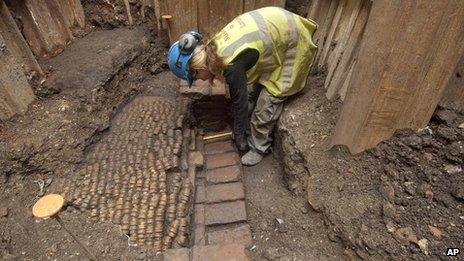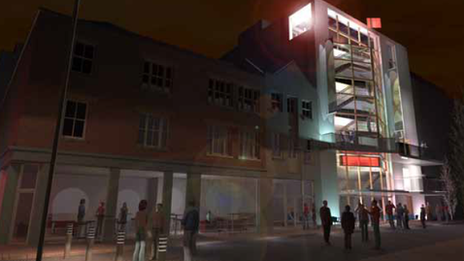What happened to William Shakespeare's theatres?
- Published

Many visitors wrongly assume the reconstructed Shakespeare's Globe is on the site of the original
It is 450 years since William Shakespeare was born and there are events planned around the world to mark the anniversary. Yet one pleasure denied even the biggest Shakespeare fanatic will be to watch his work in a theatre which he wrote for or acted in.
In London, no purpose-built theatres survive from his day. Where did they all go?
Peter Sillitoe strides into New Inn Broadway, London EC2, aware that for a theatre-lover disappointment is about to follow.
Nonetheless, he's used to explaining why this unloved little street in Shoreditch is vital to the history of drama.
He's the perfect person to tour London's Shakespeare sites with.
For two years Sillitoe worked on the ShaLT (Shakespearean London Theatres) project. It pulled together existing research about the playhouses of London during Shakespeare's career as a writer (roughly 1588 to 1612).
From 1576 the street in Shoreditch was home to The Theatre, the first purpose-built home for drama in Britain since Roman times. As a hungry young actor, Shakespeare made his home there after moving from Warwickshire to London.

A new 235-seat theatre has been proposed on the site of The Theatre
"Until that point performances were mainly in grand private homes or in taverns," says Sillitoe. "There was just no concept of a theatre being a building in its own right.
"From the 1570s that started to change - possibly because London was growing, and there were more people demanding intelligent entertainment."
Even the word theatre, as opposed to playhouse, may have evoked comparison with Greek and Roman culture.
Sillitoe taps the shabby grey hoardings on New Inn Broadway which mask The Theatre's foundations, uncovered in 2008. "Some scholars believe this may have been where Romeo and Juliet was first performed.
"It's not an easy connection to make these days, but I encourage people to use their mind's eye and conceive of how this area was when Shakespeare was a young man."
Today, a new 235-seat theatre is proposed as part of the site's redevelopment.
A year after The Theatre opened came The Curtain, built about 100 yards to the south. Three years ago, part of the Curtain's foundations were located during excavation work.
Now a major redevelopment has been approved by Hackney Council that will include a permanent display of the Curtain's foundations.
Sillitoe says there is increasing pressure to rebuild this part of London. "The area went untouched for decades, but now we're discovering more about what lies beneath.
"Though I'm not sure much of what's going up will evoke the England of the 16th and early 17th Centuries." So he suggests a side trip to investigate where Shakespeare lived while he wrote.

A permanent display of the Curtain's foundations has been proposed
From the early 1600s, the writer lodged with a refugee Huguenot family in Silver Street, Cripplegate - now part of the Barbican. It is possible that while there he wrote King Lear and Macbeth.
Legal documents mean we know more about his time in Silver Street than at any other London address. But Silver Street, like the theatres of Shoreditch, has effectively disappeared.
The closest we get is the massive underground car park which lurks beneath London Wall on the same spot.
Not inappropriately, hidden at its far end, is a chunk of London wall which may have stood close to where Shakespeare lodged. "It's not much," admits Sillitoe. "But outside of Stratford-upon-Avon it's the closest we get to anywhere Shakespeare slept and ate. It's frustrating."
In 1599 Shakespeare's theatre group, the Chamberlain's Men, abandoned Shoreditch and headed south of the river to establish the Globe theatre. The site is just down river of where Southwark Bridge now stands.
It is not to be confused with the reconstructed Shakespeare's Globe a few minutes away. Those who run the new theatre, opened in 1997, have always made clear it's not on the exact site of the original Globe, though many visitors assume otherwise.

The Museum of London Archaeology uncovered a yard and gallery walls from The Curtain Theatre
The location of the original Globe, off Park Street, was identified only in the late 1980s. Today it is indicated by a large plaque in the cobbles.
Peter Sillitoe laments that the site, almost inevitably, is now a car park. "At least this one isn't underground," he says.
Almost opposite stand the far more extensive remains of The Rose, opened before the Globe in 1587. In 1989 the foundations were deliberately flooded to keep them from crumbling in the air.
"Maybe it's inevitable," Sillitoe continues, "but Sam Wanamaker made such a success of Shakespeare's Globe that The Rose has sometimes been a bit forgotten.
"The Rose is a fascinating place and more intact than the sites north of the Thames. It's worth visiting and gives you a sense of what it must have been like in Shakespeare's time."
It is thought The Rose played host to Titus Andronicus, one of Shakespeare's earliest plays. But Peter Sillitoe gives a warning: "Academics debate endlessly where individual plays were acted, but the truth is the companies played wherever was available.

A digital reconstruction of how the inside of The Rose would have looked
"Hamlet or King Lear didn't settle down for a nice six-month run somewhere. Actors were more like wandering minstrels."
Any theatre fan would love to be able to walk into The Theatre or The Curtain or The Rose. "But they were all destroyed, says Sillitoe.
"Partly by Puritan distaste for theatre in the 1640s, and then by the Great Fire of 1666. Later came World War II bombing and, I'm afraid, an indifference to the buildings' fate generally."
To finish the tour, Peter Sillitoe takes me to Shakespeare's Globe. It is filled with visitors.
"No one really predicted it, but the success of a well-researched reconstruction like this has been a massive help to something like the ShaLT project," he says. "A whole new public interest arose which simply hadn't been there.
"Compare today to where we were 30 years ago. We know a lot more about The Theatre and The Curtain and excavation has at least begun there. What survives of The Rose is open to view, and the public has taken Shakespeare's Globe to its heart in a way no one expected.
"The negative is that we don't have a Shakespearean theatre functioning on its exact original site. Probably we never will.
"But William Shakespeare would be amazed at what we can learn about his world all these centuries later, just by walking around London for three or four hours and taking careful note."
- Published7 February 2013

- Published7 June 2012
